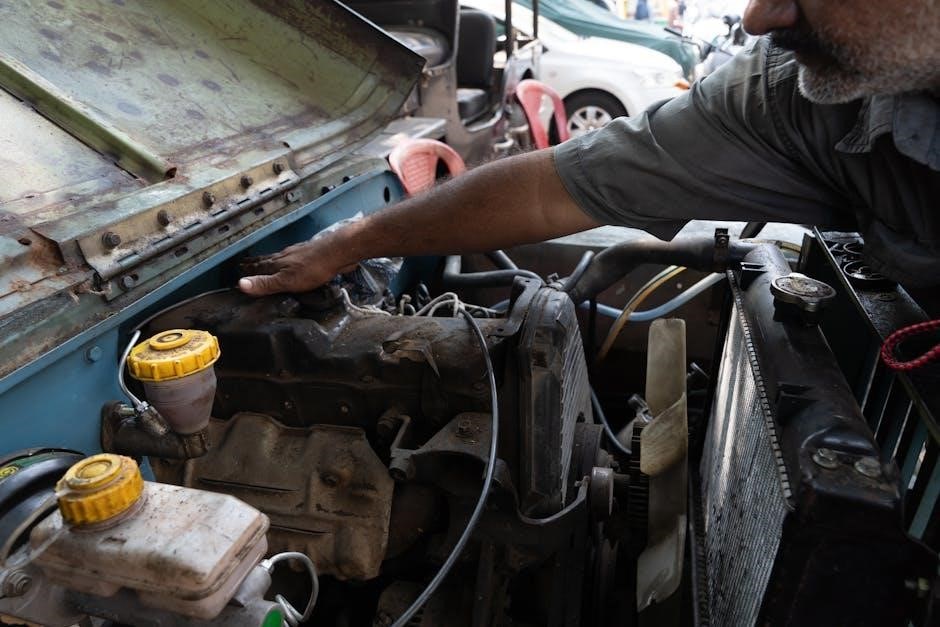jeep patriot manual

The Jeep Patriot Manual is your essential guide to understanding and maintaining your vehicle․ It provides detailed instructions for optimal performance, safety, and care, ensuring a smooth driving experience․
Overview of the Jeep Patriot
The Jeep Patriot is a compact SUV produced from 2007 to 2017, known for its rugged design and off-road capabilities․ It offers a range of engine options, including a 2․0-liter and 2․4-liter four-cylinder, paired with manual or automatic transmissions․ Available in Sport, Latitude, and Limited trims, the Patriot balances affordability with features like 4×4 systems, making it a versatile choice for both urban and off-road environments․ Owners appreciate its practicality, though some report reliability issues in older models․ Proper maintenance, as outlined in the manual, is key to optimizing performance and longevity․
Importance of the Owner’s Manual
The Jeep Patriot Owner’s Manual is a vital resource for drivers, providing essential information to ensure safe and efficient vehicle operation․ It details routine maintenance schedules, troubleshooting tips, and guidelines for optimal performance․ By following the manual’s instructions, owners can prevent potential issues, reduce repair costs, and extend the vehicle’s lifespan․ Additionally, it serves as a comprehensive guide for understanding advanced features and addressing common concerns, making it indispensable for both new and experienced drivers to maximize their Jeep Patriot’s capabilities and reliability․
How to Use the Manual Effectively
To use the Jeep Patriot manual effectively, start by reviewing the table of contents to locate specific information quickly․ Familiarize yourself with key sections like maintenance schedules, troubleshooting, and safety features․ Refer to the manual before performing any repairs or adjustments to ensure correctness․ Regularly update your knowledge with any supplementary materials provided․ Always keep the manual in your vehicle for easy access during emergencies or unexpected situations․ By following these steps, you can maximize the manual’s benefits, enhancing your driving experience and vehicle longevity․

Key Features of the Jeep Patriot
The Jeep Patriot offers a range of features, including engine options, manual and automatic transmissions, 4×4 capability, advanced safety features, and impressive fuel efficiency for its class․
Standard and Optional Features
The Jeep Patriot comes with standard features like power windows, remote keyless entry, and a six-speaker audio system․ Optional upgrades include leather-trimmed seats, a navigation system, and a sunroof․ The Sport model offers basic amenities, while higher trims add luxury touches like heated seats and steering wheel controls․ Both manual and automatic transmissions are available, and four-wheel drive can be added for enhanced off-road capability․ These features ensure the Patriot is customizable to meet diverse driver preferences, balancing comfort and functionality seamlessly․
Model Variations (Sport, Latitude, Limited)
The Jeep Patriot is available in three distinct models: Sport, Latitude, and Limited․ The Sport model offers a no-frills, budget-friendly option with essential features․ The Latitude trim adds more utility and style, including additional amenities for comfort․ The Limited model provides a premium experience with advanced features and luxurious touches․ Each variation caters to different driver needs, whether prioritizing affordability, practicality, or high-end comfort․ This range ensures the Patriot appeals to a broad audience, from budget-conscious buyers to those seeking a more refined driving experience․
Transmission Options (Manual and Automatic)
The Jeep Patriot offers both manual and automatic transmissions, catering to diverse driving preferences․ The 5-speed manual transmission provides precise control and fuel efficiency, ideal for off-road adventures and city driving․ The automatic transmission offers smooth shifting and convenience, perfect for daily commutes․ Both options are paired with the drivetrain to enhance performance․ The manual transmission is favored by enthusiasts for its hands-on experience, while the automatic appeals to those seeking ease and comfort․ This versatility ensures the Patriot meets various driving needs, whether on-road or off-road․

Maintenance and Care
Regular maintenance ensures your Jeep Patriot runs efficiently and lasts longer․ Schedule routine checks, oil changes, and tire rotations as outlined in the manual for optimal performance․
Routine Maintenance Schedule
The Jeep Patriot manual outlines a detailed routine maintenance schedule to ensure optimal performance․ Owners are advised to follow intervals for oil changes, tire rotations, and filter replacements․ Regular inspections of brakes, belts, and fluids are also recommended․ Adhering to this schedule helps prevent mechanical issues and extends the vehicle’s lifespan․ Additionally, the manual specifies particular checks for the 4×4 system and drivetrain components, ensuring reliability both on and off the road․ By following these guidelines, drivers can maintain their Patriot in top condition and enjoy a trouble-free driving experience․
Oil Change and Fluid Check Guidelines
The Jeep Patriot manual emphasizes the importance of regular oil changes and fluid checks to maintain engine health․ It recommends using the specified oil type and viscosity for optimal performance․ Fluid levels, including coolant, transmission, and brake fluids, should be inspected regularly․ The manual provides detailed steps for checking these fluids and guidelines for topping them off․ It also outlines the recommended frequency for oil changes, typically every 5,000 to 7,500 miles, depending on driving conditions․ Following these guidelines helps prevent engine wear and ensures the vehicle operates efficiently․ Always refer to the manual for specific instructions tailored to your Patriot․
Tire Pressure and Rotation Recommendations
The Jeep Patriot manual provides clear guidelines for maintaining proper tire pressure and rotation․ It recommends checking tire pressure monthly and before long trips, using the specified pressure levels found on the tire information placard․ Underinflated tires can lead to reduced fuel efficiency and increased wear․ For tire rotation, the manual suggests following a specific pattern every 6,000 to 8,000 miles to ensure even tread wear․ Proper rotation extends tire life and enhances vehicle stability․ Always refer to the manual for exact specifications tailored to your Patriot’s make and model year․

Performance and Specifications
The Jeep Patriot offers a range of engine options and transmissions, delivering impressive fuel efficiency and robust performance․ This combination ensures a smooth and capable driving experience․
Engine Options and Specifications
The Jeep Patriot is equipped with a 2․0-liter or 2․4-liter 4-cylinder engine, delivering reliable performance and fuel efficiency․ The 2․0-liter engine produces 158 horsepower, while the 2․4-liter option offers 172 horsepower․ Both engines are paired with a 5-speed manual transmission, ensuring smooth gear shifting and optimal power delivery․ With a focus on balancing power and efficiency, these engines provide excellent acceleration for city driving and sufficient torque for off-road adventures․ The Patriot’s engine specifications are designed to meet the needs of various driving conditions, making it a versatile choice for everyday use and outdoor excursions․
Transmission and Drivetrain Details
The Jeep Patriot offers a 5-speed manual transmission, known for its smooth shifting and driver control․ It also features a continuously variable transmission (CVT) option, enhancing fuel efficiency․ The Patriot boasts a Freedom Drive I 4×4 system, providing all-wheel traction for improved stability․ The drivetrain includes a lockable center coupling for off-road conditions, ensuring optimal torque distribution․ Whether navigating city streets or rugged terrain, the Patriot’s transmission and drivetrain options deliver versatility and performance, catering to diverse driving preferences and needs․
Fuel Efficiency and Range
The Jeep Patriot achieves an estimated 23 MPG in the city and up to 30 MPG on the highway with its 2․4-liter engine and manual transmission․ Automatic models slightly lower these figures due to added weight and torque converter inefficiency․ Proper tire pressure, regular oil changes, and maintaining the recommended driving habits can optimize fuel efficiency․ The Patriot’s 13․5-gallon fuel tank allows for a maximum range of approximately 405 miles on the highway․ By following the manual’s maintenance guidelines, owners can ensure their vehicle operates at peak efficiency, reducing fuel costs and environmental impact over time․

Troubleshooting and Repair
This section helps identify and resolve common issues with your Jeep Patriot, providing step-by-step solutions and diagnostic tips to keep your vehicle running smoothly and efficiently․
Common Issues and Solutions
Common issues with the Jeep Patriot include transmission problems, excessive oil consumption, and clutch failures․ Many owners have reported frequent alternator replacements due to electrical system malfunctions․ Additionally, some models experience clutch slipping and difficulty shifting gears, particularly in manual transmissions․ Regular maintenance, such as oil changes and fluid checks, can help prevent these issues․ Consulting the manual for diagnostic procedures and adhering to the recommended maintenance schedule are crucial for addressing and resolving these problems effectively․ Staying proactive with repairs ensures optimal performance and longevity of your vehicle․
Diagnosing Problems Using the Manual
The Jeep Patriot Manual provides a detailed diagnostic section to help identify and resolve issues; Refer to the troubleshooting guide for specific symptoms, such as transmission problems or electrical malfunctions․ Use the manual to locate error codes and understand their meanings․ Checking the vehicle’s history using the VIN can reveal open recalls or previous repairs․ Regularly reviewing the manual ensures familiarity with diagnostic procedures, enabling owners to address issues promptly․ By following the manual’s guidance, drivers can identify and resolve problems efficiently, minimizing downtime and maintaining optimal vehicle performance․
Cost of Repairs and Maintenance
The cost of repairs and maintenance for a Jeep Patriot varies depending on the issue and parts required․ Routine services like oil changes and tire rotations are relatively affordable, averaging $50-$100․ Replacing major components, such as the alternator or transmission, can range from $300 to $2,000 or more․ Using the manual to identify problems early can help reduce repair costs․ Additionally, checking for open recalls using the VIN can prevent unnecessary expenses․ Regular maintenance, as outlined in the manual, ensures longevity and minimizes costly surprises, making it a wise investment for vehicle care․

4×4 System and Off-Road Capabilities
The Jeep Patriot’s 4×4 system enhances traction and control on various terrains․ Its off-road capabilities make it suitable for challenging conditions, ensuring a robust and reliable performance in rugged environments․
How the 4×4 System Works
The Jeep Patriot’s 4×4 system operates by transferring power from the engine to all four wheels, enhancing traction and stability․ It features a transfer case that distributes torque between the front and rear axles, ensuring optimal grip on various surfaces․ The system can operate in 2WD mode for everyday driving, switching to 4WD for improved control on slippery or uneven terrain․ A low-range mode is also available for extreme off-road conditions, providing additional torque for climbing steep inclines or navigating rough landscapes․ This setup allows the vehicle to adapt seamlessly to different driving scenarios, maximizing both on-road comfort and off-road capability․ Always consult the manual for specific operation guidelines to ensure proper use and maintenance of the 4×4 system․
Optimizing Off-Road Performance
To maximize the Jeep Patriot’s off-road capabilities, ensure the 4×4 system is properly engaged and adjust tire pressure for improved traction․ Use low-range mode for steep inclines or heavy towing, and avoid sudden acceleration on uneven terrain․ Regularly inspect suspension and drivetrain components for damage․ Equipping your vehicle with off-road tires and skid plates can enhance durability․ Always test water depth before crossing and avoid driving in deep water without a snorkel․ Keep speeds low and maintain control to minimize wear and tear․ Consult the manual for specific guidelines on optimizing your Patriot’s off-road performance․
Safety Tips for Off-Road Driving
Always wear seatbelts and ensure all passengers do the same․ Familiarize yourself with terrain before driving, avoiding water deeper than recommended․ Reduce speed on uneven surfaces to maintain control․ Use 4×4 mode for improved stability․ Carry essential recovery tools and a first-aid kit․ Avoid driving alone; inform someone of your route and expected return time․ Stay alert and avoid distractions․ If stuck, follow proper recovery procedures․ Keep emergency contacts accessible․ Regularly check vehicle readiness before trips․ Adhere to these tips for a safer off-road experience․

Safety Features and Precautions
The Jeep Patriot Manual emphasizes advanced safety features like airbags, anti-lock brakes, and electronic stability control․ Regular maintenance and adherence to guidelines ensure optimal vehicle performance and passenger safety․
Standard Safety Features
The Jeep Patriot is equipped with a range of standard safety features to protect occupants․ These include dual front airbags, side curtain airbags, and a reinforced body structure for enhanced protection in collisions․ The vehicle also features anti-lock brakes (ABS) and electronic stability control, which help maintain traction and control on various road conditions․ Additionally, the Patriot includes a tire pressure monitoring system to ensure optimal tire inflation, further improving safety and handling․ These features work together to provide a secure driving environment for both drivers and passengers․
Precautions for Safe Driving
Always follow traffic laws and drive defensively to ensure safety․ Wear seatbelts at all times, and ensure all passengers do the same․ Avoid distractions like using electronic devices while driving․ Regularly check and maintain proper tire pressure, brakes, and suspension for optimal control․ Use headlights appropriately to increase visibility․ Be cautious in adverse weather conditions, reducing speed and increasing following distance․ Familiarize yourself with the vehicle’s safety systems, such as ABS and electronic stability control, but never rely solely on them․ Stay alert and anticipate potential hazards to maintain a safe driving environment․
Emergency Procedures
In case of an emergency, stay calm and follow established protocols․ For accidents, turn on hazard lights, secure the scene, and call for assistance․ If a fire occurs, evacuate immediately and use a fire extinguisher if trained․ In case of a breakdown, move to a safe location and use warning triangles or flares․ Always keep an emergency kit with essentials like a first-aid kit, flashlight, and reflective vest․ Familiarize yourself with the manual’s emergency section for specific guidance on handling various situations safely and effectively․

Accessories and Upgrades
Explore the best accessories and upgrades to enhance your Jeep Patriot’s performance, style, and functionality, ensuring a personalized driving experience tailored to your preferences and needs․
Popular Accessories for the Jeep Patriot
Enhance your Jeep Patriot with popular accessories like roof racks for extra storage, cargo organizers for better space management, and off-road lighting for improved visibility․ Interior accessories such as seat covers, floor mats, and steering wheel wraps add comfort and protection․ Performance upgrades like air intake systems and suspension lifts can boost capabilities․ Exterior styling elements, including grille guards and alloy wheels, personalize your vehicle․ These accessories are designed to enhance functionality, comfort, and aesthetics, ensuring your Jeep Patriot meets your lifestyle needs and preferences․
Upgrading Your Vehicle for Better Performance
Upgrading your Jeep Patriot can significantly enhance its performance․ Consider installing a cold air intake to improve engine airflow and increase horsepower․ A performance exhaust system can also boost power and provide a sportier sound․ Suspension upgrades, such as lifted coils or shocks, improve off-road capabilities and stability․ Additionally, upgrading to high-performance tires ensures better traction and handling․ For enthusiasts, aftermarket engine tuning or ECU modifications can unlock more power․ Always ensure upgrades are compatible with your vehicle and consult a professional for installation to maintain safety and warranty compliance․
Installing Aftermarket Parts
Installing aftermarket parts on your Jeep Patriot can enhance its performance and functionality․ Always ensure compatibility with your vehicle’s make and model․ Consult the owner’s manual or manufacturer guidelines for specific installation requirements․ Professional installation is recommended for complex modifications to avoid damage or safety risks․ Research reputable brands and read reviews to find reliable aftermarket components․ Additionally, check for any recalls using your VIN to ensure your vehicle is up to date․ Proper installation and compatibility are crucial for maintaining your vehicle’s warranty and ensuring optimal performance․

Owner Experiences and Reviews
Jeep Patriot owners share mixed experiences, with some praising its durability and off-road capability while others report issues with transmission and reliability over time․
Best and Worst Model Years
The Jeep Patriot’s best model years are generally considered to be from 2011 to 2017, with 2011 often highlighted for its reliability improvements․ Earlier models, such as those from 2007 to 2010, faced criticism for mechanical issues and lower build quality․ Owners report that post-2011 models saw significant enhancements in performance and durability․ However, some common complaints persist, including transmission problems and oil leaks in higher-mileage vehicles․ When purchasing a used Patriot, it’s advisable to focus on later model years and ensure proper maintenance records are reviewed․ Additionally, checking the vehicle’s history and VIN can help identify potential concerns․
Common Complaints and Solutions
Common complaints about the Jeep Patriot include transmission issues, oil leaks, and electrical problems․ Many owners report difficulties with the clutch and gear shifting, particularly in manual transmission models․ Regular fluid checks and using the correct transmission fluid can help mitigate these issues․ Oil leaks often stem from worn engine gaskets, which may require replacement․ Electrical problems, such as faulty sensors, can be resolved by updating the TIPM (Totally Integrated Power Module) software․ Addressing these issues promptly can improve performance and longevity․ Always consult the manual for diagnostic guidance and consider professional assistance for complex repairs․
Owner Tips and Tricks
Owners recommend regular maintenance to keep your Jeep Patriot running smoothly․ Monitor transmission fluid levels and replace them as needed to prevent shifting issues․ Check tire pressure monthly for optimal fuel efficiency and handling․ Keep the owner’s manual handy for quick reference during troubleshooting․ Schedule annual inspections to catch potential problems early․ Consider upgrading to synthetic oil for better engine performance․ Join Jeep Patriot forums or communities for advice and shared experiences․ Always use genuine parts for repairs to ensure compatibility and durability․ These tips can enhance your driving experience and extend your vehicle’s lifespan․

Buying a Used Jeep Patriot
When purchasing a used Jeep Patriot, check service history, mileage, and inspect for wear․ Test drive to ensure smooth transmission and 4×4 functionality․ Review vehicle history reports and VIN for recalls․ Focus on well-maintained models, avoiding those with high mileage or unresolved issues․ Negotiate based on any needed repairs․ A thorough inspection ensures a reliable purchase․
What to Look for When Purchasing
When buying a used Jeep Patriot, inspect the vehicle’s service history and mileage․ Check for signs of wear on the engine, transmission, and 4×4 system․ Look for any recalls using the VIN and review the vehicle history report․ Test drive to ensure smooth shifting and proper functionality of the clutch and gears․ Inspect the condition of the alternator, as it is a common issue in older models․ Check the tires for even wear and ensure proper tire rotation․ Negotiate the price based on any needed repairs or maintenance․ A thorough inspection helps avoid future costly surprises․
Checking the Vehicle History
When purchasing a used Jeep Patriot, obtain the Vehicle Identification Number (VIN) to check for any open recalls or service history․ Use services like Carfax or AutoCheck to review the vehicle’s past ownership, accidents, and maintenance records․ Ensure the mileage aligns with the service history to avoid potential fraud․ Check for any unresolved issues or recurring problems, such as alternator or transmission faults, which are common in certain model years․ A clean history report and proper documentation can provide peace of mind and help negotiate a fair price․ This step is crucial for avoiding costly surprises down the road․
Negotiating the Best Price
Negotiating the best price for a used Jeep Patriot requires research and strategy․ Start by determining the vehicle’s market value using tools like Kelley Blue Book or Edmunds․ Review the vehicle history report to identify any issues that could lower the price․ Highlight needed repairs or high mileage to negotiate a better deal․ Be transparent about your budget and compare prices of similar models․ Don’t hesitate to walk away if the seller is unwilling to compromise․ A well-prepared approach ensures you secure a fair and reasonable price for your Jeep Patriot․
The Jeep Patriot Manual serves as a comprehensive guide to understanding, maintaining, and optimizing your vehicle․ Use it to explore its features, ensure proper care, and enhance its performance․
Final Thoughts on the Jeep Patriot Manual
The Jeep Patriot Manual is a vital resource for owners seeking to maximize their vehicle’s potential․ It provides clear guidance on maintenance, troubleshooting, and optimizing performance․ By following the manual’s instructions, drivers can ensure their Patriot runs efficiently and safely․ Regular maintenance, such as oil changes and tire rotations, is emphasized to prevent issues․ The manual also aids in diagnosing common problems, reducing repair costs․ Whether for daily driving or off-road adventures, the Jeep Patriot Manual empowers owners with knowledge to get the most out of their vehicle․ It’s a cornerstone for responsible ownership and enhanced driving experiences․
Encouragement to Explore and Maintain Your Vehicle
Take the time to explore your Jeep Patriot’s features and capabilities through the manual․ Regular maintenance, such as oil changes and tire rotations, ensures optimal performance․ Understanding your vehicle’s needs empowers you to address issues early, preventing costly repairs․ By following the manual’s guidance, you can enhance your driving experience and extend the life of your Patriot․ Embrace the adventure, whether on-road or off, with confidence in your vehicle’s reliability․ Stay proactive, and enjoy the freedom that comes with owning a well-maintained Jeep Patriot!
Leave a Reply
You must be logged in to post a comment.